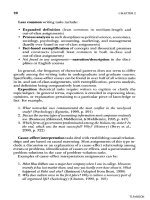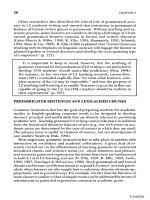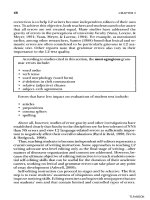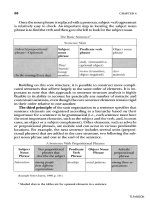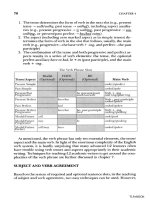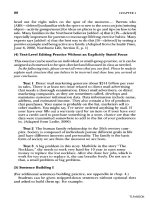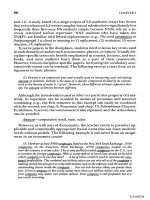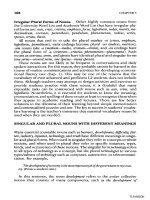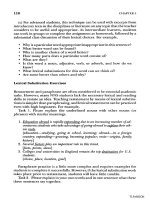Tài liệu Teaching academic ESL writing part 3 doc
Bạn đang xem bản rút gọn của tài liệu. Xem và tải ngay bản đầy đủ của tài liệu tại đây (748.25 KB, 10 trang )
8
CHAPTER
1
A
large number
of
studies have also established that learning
to
write
in a
second language
and,
in
particular, learning
to
write
the
formal
L2
aca-
demic prose crucial
in
NNSs' academic
and
professional careers requires
the
development
of an
advanced linguistic foundation, without which
learners simply
do not
have
the
range
of
lexical
and
grammar
skills
re-
quired
in
academic writing (Berkenkotter
&
Huckin,
1995;
Bizzell,
1982;
Byrd
&
Reid,
1998;
Chang
&
Swales,
1999;
Grabe
&
Kaplan,
1996;
Hamp-Lyons,
1991a, 1991b; Hinkel, 1999a, 2002a; Horowitz, 1986a,
1986b, 1991; Hvitfeld, 1992
Johns, 1981, 1991,
1997
Jordan,
1997; Kroll,
1979; Nation,
1990,
2001; Nation
&
Waring, 1997; Ostler,
1980;
Paltridge,
2001;
Poole,
1991;
Raimes,
1983, 1993;
Read, 2000; Santos,
1984, 1988;
Swales,
1971).
Assumption
2:
Writing Pedagogy
for NSs
with
Highly
Developed
(Native)
Language Proficiency, Which NNSs
(By
Definition)
Do Not
Have,
Is Not
Readily
Applicable
to L2
Writing Instruction
Prior
to the
1980s,
the
teaching
of
university-level
rhetoric
and
composi-
tion
was
predominantly concerned with analyzing literature
and the
stu-
dents' writing style, lexical precision
and
breadth, grammar,
and
rhetorical structure (e.g.,
the
presence
of
thesis
and
rhetorical support,
co-
herence,
and
cohesion).
The
teaching
and
evaluation
of
student writing
focused almost exclusively
on the
product
of
writing without explicit
in-
struction
of how
high-quality writing could
be
attained.
In
reaction
to
rigid
and
somewhat restrictive
views
of
stylistic
quality
and
evaluations
of
writing,
L1
methodologies
for
teaching writing
and
composition began
to
move
away
from
a
focus
on the
product
of
composing, classical rhetorical
formality,
study
of
literature,
and
accepted
standards
for
grammatical
ac-
curacy
(Hairston, 1982). Instead
the
humanistic teaching
of
composition
began
to
emphasize
the
writing process with
a
reduced emphasis
on
rhe-
torical structure, vocabulary,
and
grammar.
In the
late 1970s
and
early 1980s, some specialists
in the
teaching
of L1
basic writing observed
that
a
number
of
similarities exist
among
the
strate-
gies used
by
basic
NS and NNS
writers. Therefore, they concluded that
if
the
writing behaviors
of
both types
of
writers exhibit similarities,
the ap-
proaches
to
teaching writing
to NSs can be
applied
to the
teaching
of
NNSs.
Although
at
that time
the
research
on the
applicability
of L1
writing peda-
gogy
to
learning
to
write
in L2
consisted
of
only
a
small number
of
case stud-
ies
and
student self-reports,
the
methodology
for
teaching basic
L1
writers
took hold
in the
teaching
of
NNSs.
Following
the
methodological
shift
in L1
writing
pedagogy,
the
process-centered paradigm
was
similarly adopted
as
the
preeminent methodology
in
teaching
L2
writing (i.e.,
in L2
instruction
focused
on the
process
of
writing,
the
quality
of
writing
is
evaluated based
TLFeBOOK
ONGOING GOALS
IN
TEACHING
ESL
SKILLS
9
on
prewriting, drafting,
and
revising; Reid, 1993).
The
process methodol-
ogy
further
presupposes that issues
of L2
grammar
and
lexis
are to be ad-
dressed only
as
needed
in the
context
of
writing,
and
that
if
NNSs
with
proficiency
levels higher than beginning
are
exposed
to
text
and
discourse
to
learn
from,
they
will
acquire
L2
grammar
and
lexis naturally. Teaching
ESL
writing through
the
writing process
and
revising multiple
drafts
also
permitted
many
ESL
practitioners
to
hope
that over time,
as L2
writers
de-
veloped
and
matured, their
L2
errors
and
concerns about linguistic accu-
racy
in
grammar
and
vocabulary
use
would decrease (Zamel, 1982, 1983).
Another reason
for the
enormous popularity
of
process instruction
for
NNSs
lies
in the
fact
that
the
teaching
of L1
writing relied
on the
research
and
experience
of the
full-fledged
and
mature discipline
of
rhetoric
and
composition.
Theoretically,
the
teaching
of the
writing process allowed
ESL
teachers
and
curriculum designers
to
accomplish their instructional goals
based
on
solid
research
findings
and
pedagogical
frameworks (Leki, 1995),
which
were developed, however,
for a
different
type
of
learners.
In
addition, because many
ESL
practitioners were trained
in
methodolo-
gies
for
teaching
the
writing process, employing these approaches, tech-
niques,
and
classroom
activities
entailed working
with
known
and
familiar
ways
of
teaching.
However,
the new
instructional methodology centered squarely
and al-
most
exclusively
on the
writing process that fundamentally overlooked
the
fact
that
NNS
writers
may
simply lack
the
necessary language skills (e.g.,
vo-
cabulary
and
grammar)
to
take advantage
of the
benefits
of
writing
process
instruction. Furthermore,
the
process methodology
for
teaching focused
disproportionately
on
only
the
first
of
three components that
are
essential
to
produce good academic writing:
(1) the
process
of
writing
with
self-revi-
sion
and
editing,
(2)
formal rhetorical organization,
and (3)
quality
of
lan-
guage (e.g., grammatical
and
lexical accuracy).
In
addition, although
the
methodologies
for
teaching
L2
writing changed,
in the
academic arena
as-
sessment
of
student writing
has
remained focused
on the end
product
with-
out
regard
to the
writing process required
to
arrive
at the end
product.
Differences Between
L1 and L2
Writing
The
differences
between
LI and L2
writing
are so
extensive that they
can be
identified
in
practically
all
aspects
of
written text
and
discourse. According
to
numerous
studies
of LI and L2
written discourse
and
text, distinctions
between
them extend
to:
•
discourse
and
rhetorical organization
•
ideas
and
content
of
writing
•
rhetorical modes (e.g., exposition, narration,
and
argumentation)
•
reliance
on
external knowledge
and
information
TLFeBOOK
10
CHAPTER
1
•
references
to
sources
of
knowledge
and
information
•
assumptions about
the
reader's knowledge
and
expectations (e.g.,
references
to
assumed common knowledge
and
familiarity
with
certain classical works)
• the
role
of
audience
in
discourse
and
text production,
as
well
as the
appraisal
of the
expected discourse
and
text complexity (e.g.,
reader
vs.
writer responsible text)
•
discourse
and
text cohesion
•
employment
of
linguistic
and
rhetorical features
of
formal written
text (e.g.,
fewer/less
complex sentences, descriptive adjectives,
passivization, nominalization, lexical variety,
and
more
conjunc-
tions,
conversational amplifiers
and
emphatics, simple nouns
and
verbs)
(Bickner
&
Peyasantiwong, 1988; Byrd
&
Nelson, 1995;
Carlson, 1988; Connor, 1996; Connor
&
Carrell, 1993; Connor
&
Kaplan,
1987; Davidson, 1991; Friedlander, 1990; Grabe
&
Kaplan,
1989, 1996; Hamp-Lyons, 1990, 199la, 1991b; Hinds,
1983, 1987, 1990; Hinkel, 1994, 1995a, 1995b, 1997b, 1999a;
Hyland, 1999, 2002a; Hyland
&
Milton, 1997; Hvitfeld, 1992;
Indrasuta, 1988; Johnstone, 1989; Kachru, 1999; Kaplan 1983,
1987, 1988, 2000; Kroll, 1990; Leki, 1995; Matalene, 1985;
Silva,
1990, 1993, 1997).
In
addition
to
numerous studies
of the L1 and L2
writing product,
other
studies
have identified fundamental
and
substantial differences between
approaches
to
writing
and
writing processes
in L1 and L2
(Jones, 1985;
Jourdenais, 2001; Widdowson, 1983).
For
instance, Raimes (1994) reported
that although writing
ability
in an L1 is
closely linked
to
fluency
and
conven-
tions
of
expository discourse,
L2
writing requires
a
developed
L2
profi-
ciency,
as
well
as
writing
skills
that pertain
to the
knowledge
of
discourse
conventions
and
organizing
the
information
flow.
Similarly, Gumming's
(1994)
empirical study pointed
out
that
L2
proficiency
and
expertise
in
writing
are in
fact
two
"psychologically"
different
skills;
as
individuals gain
L2
proficiency,
"they become better able
to
perform
in
writing
in
their sec-
ond
language, producing more
effective
texts"
(p.
201),
and
attend
to
larger
aspects
of
their
writing production.
He
further
underscored
that
L2
profi-
ciency
adds
to and
enhances
L2
writing expertise.
An
extensive study
by
Warden (2000) found that "implementing
a
multi-
ple-stage process"
of
draft revising
in
writing pedagogy represents
a
mis-
match
with
the
reality
of
"social, cultural,
and
historical trends"
(p.
607)
in
non-Western
countries, where
the
emphasis
is
placed
on
vocabulary
and
grammar accuracy rather than revising one's writing
for
meaning
and
con-
tent.
In his
study, over
100
Taiwanese students revised multiple drafts,
showing
that redrafting
essays
results
in
generally unproductive writing
strategies, such
as
correcting incremental phrase-level errors. Warden also
TLFeBOOK
ONGOING
GOALS
IN
TEACHING
ESL
SKILLS
11
pointed
out
that "direct application
of
multiple drafts
and
non-sen-
tence-level feedback" results
in a
lower level
of
student motivation
for
revi-
sion
and
"increased
dependence
of
reference material," when students
simply
copy directly from sources.
Silva's
(1993) survey
of NNS
writing research includes
72
empirical stud-
ies
published between 1980
and
1991.
He
concluded that,
"in
general, com-
pared
to NS
writing,
L2
writers' texts were less
fluent
(fewer
words), less
accurate (more errors),
and
less
effective
(lower holistic scores)
and ex-
hibited less lexical control, variety,
and
sophistication overall"
(p.
668).
Silva
summarized
his
research overview
by
stating that, "the research com-
paring
L1 and L2
writing
strongly suggests that
they
are
different
in
numerous
and
important
ways.
This difference needs
to be
acknowledged
and
addressed
by
those
who
deal
with
L2
writers
if
these writers
are to be
treated
fairly,
taught
effectively,
and
thus, given
an
equal chance
to
succeed
in
their writing-related personal
and
academic endeavors"
(p.
668).
Assumption
3:
Writing Personal Narratives/Opinions
("Telling"
What
One
Already Knows)
Is Not
Similar
to
Producing
Aca-
demic
Writing, Which Requires Obtaining
and
Trans-
forming Knowledge
In
their examination
of the
writing process, Bereiter
and
Scardamalia
(1985, 1987, 1989) distinguished
two
types
of
writing: knowledge telling
and
knowledge transforming. They explained that "telling" about personal
experiences
or
opinions represents
the
easiest form
of
writing production
that
is
accessible
to
practically
all
language users,
who
often perform such
tasks
in
conversations.
For
example, writing assignments such
as
My
first day
in the
United
States,
My
most
embarrassing/happiest
day,
or My
views
on
abor-
tion/animal
research
do not
require
writers
to do
much beyond telling what
they
already know
and
simply writing down their memories
or
opinions
in
response
to the
prompt.
To
produce
an
essay,
writers
need
to
organize infor-
mation, often
in a
chronological order, according
to a
form appropriate
within
the
structure
of
composition
and in
accordance
with
a
few
prescribed
conventions
for
discourse
organization (e.g., overt topic markers
and/or
lists
of
reasons—my
first
reason,
the
second
reason,
the
third
reason,
in
conclu-
sion
) that
are
also retrieved
from
memory.
In the
case
of L2
students, such
writing
tasks
can be
produced
even within
the
constraints
of
limited vocabu-
lary
and
grammar because
the
degree
of
textual simplicity
or
complexity
demonstrated
in the
writing
is
determined
by the
writer.
Opinion essays (Bereiter
&
Scardamalia, 1987) include only
two
main
el-
ements: statement
of
belief
and
reason. Some assignments
of
this type
may
involve
multiple reasons and,
at
slightly
more advanced levels
of
writing,
anticipation
of
counterarguments,
as is
often expected
of ESL
writers
in L2
writing
instruction dealing with what
is
often
called
written
arguments
(Leki,
TLFeBOOK
12
CHAPTER
1
1999; Lunsford
&
Ruszkiewicz,
2001). Opinion writing also necessitates
knowledge telling because stating one's
views
requires little information
be-
yond
the
writer's personal
beliefs
or
thoughts.
In
these types
of
essays,
writ-
ers can
produce text
on
practically
any
topic within their available
knowledge without external information
or
support. Opinion-based
writ-
ten
assignments
or
essays report personal thoughts
in the
form
of a
simple
discourse organization that usually meets
the
expectations
of the
genre.
It
is
important
to
note that
the
teaching
of L2
writing
focuses
predomi-
nantly
on
topics purposely designed
to be
accessible
for L2
learners.
Writ-
ing
prompts
in
many
L2
writing classes
are
often
highly predictable
and
may
actually require students
to
produce personal narratives
and
experi-
ences (e.g.,
why I
want
to
study
in the
United
States,
holidays
in my
country,
the
per-
son who
influenced
me
most,
my
family,
my
favorite
sport/pet/book/movie/
class/teacher/relative).
Opinion essays
are
also ubiquitous
at
high intermedi-
ate and
advanced levels
of
pre-university ESL/EAP instruction because they
appear
to be
pseudoacademic
and are
based
on
short readings:
Please
read
the
article/text
and
give
your
reaction/response
to
(its
content
on)
pollution/gender
differences/racial
discrimination/the
homeless/urban
crime/TV
advertising/teenage
smoking/human
cloning/gays/women
in the
military.
However,
a
counterproduc-
tive
outcome
of
topic
accessibility
is
that
NNS
academically bound students
have
few
opportunities
to
engage
in
cognitively
and
linguistically
advanced
types
of
academic writing expected
of
them
in
their
university-level
courses
(Leki
&
Carson, 1997).
In
addition
to
knowledge telling
in
writing,
the
Bereiter
and
Scardamalia
model
of
writing
also addresses
a far
more psychologically complex type
of
writing
that they called
knowledge
transforming.
Knowledge transforming
ne-
cessitates
thinking about
an
issue, obtaining
the
information needed
for
analysis,
and
modifying
one's thinking. This type
of
writing
leads writers
to
expand
their
knowledge base
and
develop
new
knowledge
by
processing
new
information obtained
for the
purpose
of
writing
on a
topic. Knowledge
transforming
is
considerably more cognitively complex than knowledge
telling because writers
do not
merely retrieve information already available
to
them
in
memory,
but
derive
it
from
reading
and
integrate
with
that
al-
ready available
to
become
obtained knowledge.
Bereiter
and
Scardamalia emphasized that knowledge telling
and
knowl-
edge transforming require
different
rhetorical
and
text-generating
skills
for
producing written discourse. Such important considerations
of
writing
as
content integration, expectations
of the
audience, conventions
and
form
of
the
genre,
use of
language
and
linguistic features (e.g., lexis
and
gram-
mar), logic
of the
information
flow, and
rhetorical organization
are all
inter-
twined
in
knowledge transforming (e.g., defining terms, explaining ideas,
and
clarifying).
In
general terms, Bereiter
and
Scardamalia described
the
classical
academic model
of
writing expected
in the
disciplines when stu-
dents
are
required
to
obtain, synthesize, integrate,
and
analyze information
TLFeBOOK
ONGOING GOALS
IN
TEACHING
ESL
SKILLS
13
from
various sources, such
as
published materials, textbooks,
or
laboratory
experiments.
Advanced cognitive
and
information-processing tasks entailed
in
trans-
forming
knowledge
and
demonstrating knowledge
in
writing place great
demands
on 12
writers' language skills.
Assumption
4:
Intensive
and
Consistent
Instruction
in L2
Vocabulary
and
Grammar,
as
Well
as
Discourse
Organization,
Is
Paramount
for
Academically
Bound
NNSs
Instruction
in L2
vocabulary
and
grammar improves learners' receptive
and
productive
skills
and
provides important means
of
expanding
NNS
lex-
ical
and
syntactic repertoires necessary
in L2
reading,
constructing aca-
demic text, listening,
and
other fundamental facets
of
functioning
in the
academy.
The
effectiveness
and
necessity
of
teaching
L2
vocabulary
has
been
demonstrated
in a
large
number
of
studies such
as
Channell (1988),
Coady (1997), Cowie (1988), Coxhead (1998, 2000), Dudley-Evans
and St.
John
(1998),
N.
Ellis
(1994, 1997),
N.
Ellis
and
Beaton (1993), Harley
(1989), Huckin, Haynes,
and
Coady (1993), Hulstijn (1990, 1992, 1997),
Hulstijn
and
Laufer (2001),
Jordan
(1997),
Kelly
(1986), Laufer (1994),
Carter
and
McCarthy (1988), Nation (2001), Paribakht
and
Wesche (1993,
1997),
Santos (1988), Sinclair
and
Renouf (1988), Schmitt (2000),
and
Schmitt
and
McCarthy (1997).
For
instance, Laufer
and
Nation (1995) identified significant positive
correlations between learners' gains
on
vocabulary tests based
on Na-
tion's (1990) University Word List (see also chaps.
5, 8, and 9) and the in-
crease
of
academic vocabulary
in the
compositions written
by the
same
group
of
learners.
Similarly, Laufer (1994)
reported
that persistent
in-
struction
in L2
vocabulary increases learners' vocabulary
range
in
writ-
ing to
include
the
foundational university-level vocabulary
and
progress
beyond
it.
However, Nation (2001) cautioned that productive knowledge
of
vocabulary requires
more
learning
and
greater
motivation
for
learn-
ing
than receptive knowledge,
in
which
effective
and
measurable gains
can be
made
within
a
matter
of
days.
3
The
fact
that consistent grammar instruction
is
important
to
develop
learner language awareness
and
improvement
in the
quality
of L2
produc-
tion
has
long
been established
in the
work
of, for
example, Allen, Swain,
Harley,
and
Cummins (1990), Celce-Murcia
and
Hilles (1988),
R.
Ellis
(1984, 1989, 1990, 1994, 1997, 2001), Fotos (1994, 1998, 2002), Fotos
and
Ellis
(1991), Kumaravadivelu (1993), Mitchell
and
Martin (1997), Norris
and
Ortega (2001), Muranoi (2000), Rutherford (1984), Rutherford
and
3
As
research
has
confirmed,
it
follows
from this observation that vocabulary teaching
can re-
sult
in
improvements
in L2
reading
comprehension
earlier
than
in the
increased
quality
of
writing production (Huckin, Haynes,
&
Coady, 1993; Nation, 2001).
TLFeBOOK
14
CHAPTER
1
Sharwood Smith (1985), Sharwood Smith (1981, 1991, 1993), Schmidt
(1990, 1993, 1994), Swain (1985),
and
Williams
(1999).
A
recent study
by
Norris
and
Ortega
(2000) undertook probably
the
most
comprehensive analysis
of
published data
on the
value
of
grammar instruc-
tion.
These
authors stated that
in
many cases
it is not
easy
to
tell whether
communicative,
explicit,
or
meaning-focused instruction
led to
greater
de-
grees
of L2
learning
and
acquisition because
of the
disparate sample
sizes
and
statistical analyses employed
in
various research studies
and
publica-
tions.
Thus,
to
make sense
of
research findings published
in the
past
two de-
cades, Norris
and
Ortega
standardized
the
results
of 49
studies
on L2
learning, acquisition,
and
grammar instruction.
The
outcomes
of
their sub-
stantial
undertaking show clearly that
in L2
teaching, "focused instruc-
tional treatments
of
whatever sort
far
surpass non-
or
minimally
focused
exposure
to the L2" (p.
463).
It is
important
to
emphasize that
the
purpose
of
this book
is not to
enable
teachers
to
help
students attain
the
skills
necessary
to
become sophisticated
writers
of
fiction
or
journalistic investigative reports.
The
narrow
and in-
strumental goal
of
instruction
presented
here
deals with helping
NNS
writ-
ers
become
better
equipped
for
their
academic survival.
Furthermore, outside
of a
brief
nod in
chapter
11, the
contents
of the
book
do not
include
the
teaching
of the
macro (discourse) features
of
aca-
demic writing, such
as
introductions, thesis statements, body para-
graphs,
and
conclusions. Dozens
of
other
books
on the
market,
for
both
teachers
and
students,
address
the
organization
of
information
in
aca-
demic
and
student essays according
to the
norms
and
conventions
of
aca-
demic writing
in
English.
Although both discourse-
and
text-level features play
a
crucial
role
in
teaching
L2
writing,
the
curriculum
and
teaching techniques discussed
in
this
book
focus primarily
on
lexical, syntactic,
and
rhetorical
features
of
aca-
demic text.
The
importance
of
these features
in
text
and
discourse serve
as
the
organizing principle
for
instruction, narrowly targeting their pedagogi-
cal
utility.
Whenever possible, variations
in the
uses
of the
features across
such
different disciplines
as
business, economics, psychology,
or
sociology
are
discussed
throughout
the
volume.
This
book presents
a
compendium
of
many practical teaching tech-
niques,
strategies,
and
tactics that
a
teacher
can use in
writing
and
composi-
tion
classes
to
help
students improve
the
quality
of
their academic text.
These
include
the
teaching
of
phrase
and
sentence patterns that
are
com-
monly
found
in
academic writing
and can be
taught
in
chunks.
The
teach-
ing
of
academic nouns
and
verbs
in the
book centers
around
the
basic core
vocabulary
students must learn
to
produce writing more lexically advanced
than
can be
attained
by
means
of
exposure
to
spoken interactions
and the
conversational register.
In
addition,
the
material
in
this book covers
the
tex-
tual
and
discourse
functions
of
such important features
of
academic writing
TLFeBOOK
ONGOING
GOALS
IN
TEACHING
ESL
SKILLS
15
as
essential
verb
tenses,
passive
voice,
and
necessary
main
and
subordinate
clauses,
as
well
as
adjectives,
adverbs,
hedges,
and
pronouns.
FURTHER
READINGS ABOUT WRITTEN
ACADEMIC
TEXT
AND
DISCOURSE,
AND
TEACHING
ACADEMIC
ESL
WRITING
L2
Written
Academic
Text
and
Discourse
Atkinson,
D.
(1991). Discourse analysis
and
written discourse conventions. Annual
Review
of
Applied
Linguistics,
11,
57-76.
Bereiter,
C., &
Scardamalia,
M.
(1987).
The
psychology
of
written
composition.
Hillsdale,
NJ:
Lawrence Erlbaum Associates.
Bereiter,
C., &
Scardamalia,
M.
(1989). Intentional learning
as a
goal
of
instruction.
In L.
Resnick
(Ed.),
Knowing,
learning,
and
instruction
(pp. 361-391).
Hillsdale,
NJ:
Lawrence Erlbaum Associates.
Bratt Paulston,
C.
(1990). Educational language policies
in
Utopia.
In B.
Harley,
P.
Allen,
J.
Cummins,
& M.
Swain
(Eds.),
The
development
of
second
language
profi-
ciency
(pp.
187-197).
Cambridge: Cambridge University Press.
Byrd,
P., &
Nelson,
G.
(1995).
NNS
performance
on
writing proficiency exams:
Fo-
cus on
students
who
failed. Journal
of
Second
Language
Writing,
4,
273-285.
Carlson,
S.
(1988). Cultural differences
in
writing
and
reasoning
skills.
In A.
Purves
(Ed.),
Writing
across
languages
and
cultures:
Issues
in
contrastive
rhetoric
(pp.
109-137).
Newbury Park,
CA:
Sage.
Grabe,
W., &
Kaplan,
R. B.
(1996).
Theory
and
practice
of
writing.
London:
Longman.
Johns,
A.
(1991).
Faculty
assessment
of ESL
student literacy skills: Implications
for
writing
assessment.
In L.
Hamp-Lyons
(Ed.),
Assessing
second
language
writing
(pp.
167-180).
Norwood,
NJ:
Ablex.
Johns,
A.
(1997).
Text,
role,
and
context:
Developing
academic
literacies.
Cambridge:
Cambridge
University
Press.
Jordan,
R.
(1997). English
for
academic
purposes.
Cambridge: Cambridge University
Press.
Poole,
D.
(1991). Discourse analysis
in
enthnographic
research.
Annual Review
of
Ap-
plied
Linguistics
11,
42-56.
Teaching
Academic
ESL
Writing
Chang,
Y, &
Swales,
J.
(1999). Informal elements
in
English academic writing:
Threats
or
opportunities
for
advanced non-native speakers.
In C.
Candlin
& K.
Hyland
(Eds.),
Writing
texts,
processes
and
practices
(pp.
145-167).
London:
Longman.
Grabe,
W, &
Kaplan,
R. B.
(1989). Writing
in a
second language: Contrastive rheto-
ric.
In
D.Johnson
& D.
Roen
(Eds.),
Richness
in
writing
(pp.
263-283).
New
York:
Longman.
Grabe,
W., &
Kaplan,
R. B.
(1996).
Theory
and
practice
of
writing.
London: Longman.
Hamp-Lyons,
L.
(199la). Reconstructing academic writing proficiency.
In L.
Hamp-Lyons
(Ed.),
Assessing
second
language
writing
(pp.
127-153).
Norwood,
NJ:
Ablex.
Hamp-Lyons,
L.
(1991b). Scoring
procedures
for ESL
contexts.
In L.
Hamp-Lyons
(Ed.),
Assessing
second
language
writing
(pp.
241-277). Norwood,
NJ:
Ablex.
TLFeBOOK
16
CHAPTER
1
Paltridge,
B.
(2001).
Genre
and the
language
learning
classroom.
Ann
Arbor:
The
Uni-
versity
of
Michigan Press.
Santos,
T.
(1988). Professors' reactions
to the
academic writing
of
nonnative-speak-
ing
students. TESOL
Quarterly,
22,
69-90.
Shaw,
P., &
Liu,
E. T. K.
(1998). What develops
in the
development
of
second
lan-
guage
writing.
Applied
Linguistics,
19(2),
225-254.
Silva,
T.
(1993). Toward
an
understanding
of the
distinct nature
of L2
writing:
The
ESL
research
and its
implications. TESOL
Quarterly,
27(4),
657-676.
Silva,
T.
(1997).
On the
ethical treatment
of ESL
writers.
TESOL
Quarterly,
31(2),
359-363.
TLFeBOOK
2
Student
Writing Tasks
and
Written Academic
Genres
OVERVIEW
•
Writing requirements
in the
university
•
Most
important characteristics
of
academic writing
•
Most common written academic assignments
and
tasks
•
Essential
features
of
academic text
and
importance
of
teaching them
•
Research
findings on
explicit instruction
in L2
academic text
•
Types
of
writing tasks
in
commonly required academic courses
Although
ESL
instruction
to
non-native speakers
(NNSs)
takes place
in
various
domains
of
language
skills,
such
as
reading, speaking, listening,
and
pronunciation,
L2
learners
who
undertake
to
become proficient
L2
writers
are
usually academically bound.
In
light
of the
fact
that most stu-
dents
who
prepare
to
enter
degree
programs dedicate vast amounts
of
time
and
resources
to
learn
to
produce written academic discourse
and
text,
the
teaching
of
English
to
academically bound
NNS
students must
in-
clude
an
academic writing component. Although
it is a
verifiable
and es-
tablished
fact
that
NNS
students
need
to
develop academic writing
skills,
ESL
teachers
in
EAP, intensive,
and
college-level writing programs
do not
always
have
a
clear picture
of the
types
of
writing
and
written discourse
ex-
pected
of
students once they achieve their short-term goals
of
entering
de-
gree
programs.
In
particular, students rarely
need
to be
proficient nar-
rators
of
personal experiences
and
good writers
of
personal stories.
In
fact
what
they
need
is to
become relatively good
at
displaying academic knowl-
edge within
the
formats expected
in
academic discourse
and
text. More
important,
NNS
students' academic survival often depends
on
their abil-
ity
to
construct written
prose
of at
least passable quality
in the
context
of
academic discourse expectations. This chapter presents
an
overview
of
17
TLFeBOOK
